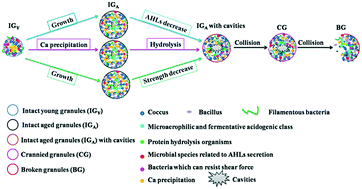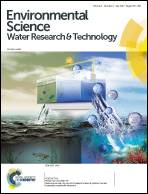Disintegration of aerobic granules during prolonged operation†
Abstract
Aerobic granular sludge technology has been implemented for industrial and municipal wastewater treatment. However, the large-scale application of this technology is still restricted by the disintegration phenomenon during prolonged operation. Herein, a comprehensive set of measurements is used in different stages of granule development to provide an integrated investigation and reasonable explanation for the disintegration phenomenon. The results show that over a period of 460 days, intact young granules (IGY) grow into larger intact aged granules (IGA), then into crannied granules (CG), and finally into broken granules (BG). Compact IGY with obvious calcium precipitation in the core grow into cavern-like structure IGA with calcium precipitation mainly on their outer and middle zones with the growth of aerobic granules. Meanwhile, an increase in microaerophilic TM7, fermentative acidogenic class Cytophagia and protein hydrolysis bacteria Saprospiraceae, as well as a decrease in microbial communities that can resist shear force and are related to N-acyl-homoserine lactones (AHLs) production are observed with the growth of aerobic granules. The two main causes for the disintegration (mass transfer limitation and microbial communities) of aerobic granules are closely related to the increase of granule size. It is critical to maintain aerobic granular sludge in a steady and healthy granule size for its prolonged operation.

- This article is part of the themed collection: Environmental Science: Water Research & Technology: Editors' Choice


 Please wait while we load your content...
Please wait while we load your content...